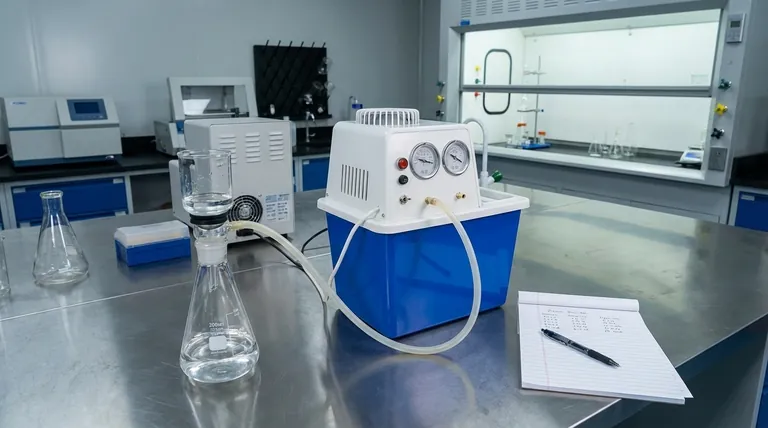Technically speaking, the performance of a vacuum pump is not measured by its "maximum pressure" but by its minimum achievable pressure. The maximum pressure in any system open to the air is simply atmospheric pressure, and the pump's job is to reduce the pressure from that starting point to the lowest possible level.
The critical metric for a vacuum pump is its ultimate vacuum—the lowest pressure it can generate under ideal conditions. This determines the "strength" or quality of the vacuum it can create.

Why "Minimum Pressure" is the Key Metric
A vacuum is a space with a gas pressure far below the surrounding atmospheric pressure. A vacuum pump functions by removing gas molecules from a sealed chamber to create this pressure difference.
The Starting Point: Atmospheric Pressure
The pressure inside the chamber before the pump is turned on is atmospheric pressure. This is the highest pressure the system will experience, roughly 101,325 Pascals (Pa) or 760 Torr at sea level.
The Goal: Reducing Pressure
The pump's entire purpose is to lower this pressure. Therefore, its performance is defined by how effectively it can remove gas molecules and how low it can drive the internal pressure. This lowest point is its ultimate pressure or ultimate vacuum.
Understanding Vacuum Levels and Units
Different applications require different qualities of vacuum. This quality is classified by the range of pressure achieved.
Common Units of Pressure
Pressure in vacuum systems is measured in several units. The standard international (SI) unit is the Pascal (Pa). Another common unit is the Torr, where 760 Torr is equal to one standard atmosphere.
Classifying Vacuum Quality
Vacuum levels are typically categorized from low to ultra-high:
- Rough/Low Vacuum: 100,000 Pa down to 100 Pa
- Medium Vacuum: 100 Pa down to 0.1 Pa
- High Vacuum (HV): 0.1 Pa down to 10⁻⁵ Pa
- Ultra-High Vacuum (UHV): Below 10⁻⁵ Pa
Different Pumps for Different Pressures
No single pump can cover the entire vacuum range. The type of pump dictates the ultimate pressure it can achieve.
Rough Vacuum Pumps
These pumps are used for applications that don't require extremely low pressures, such as filtration, degassing, or as backing pumps for more powerful systems. A circulating water vacuum pump (or water aspirator) is a common example. As noted, its ultimate vacuum is typically in the range of 2,000 to 4,000 Pa, placing it firmly in the rough vacuum category.
High and Ultra-High Vacuum Pumps
Achieving high or ultra-high vacuum requires more sophisticated technology. Pumps like turbomolecular pumps or cryopumps can achieve pressures millions of times lower than a simple water pump, reaching levels of 10⁻⁸ Pa or less. These are required for sensitive scientific instruments, semiconductor manufacturing, and particle accelerators.
Understanding the Trade-offs
The ultimate pressure listed on a pump's specification sheet is a theoretical maximum achieved under perfect conditions.
Ideal vs. Real-World Performance
In practice, the actual vacuum you achieve depends on the entire system. Leaks in seals, gas molecules released from the chamber walls (outgassing), and the type of gas being pumped will all limit the final pressure.
Pumping Speed vs. Ultimate Pressure
A pump's pumping speed (the volume of gas it can remove per unit of time) is also critical. A pump might be able to reach a very low ultimate pressure, but if its speed is too low for the chamber volume, it will take an impractically long time to get there.
Making the Right Choice for Your Goal
Selecting a pump requires matching its ultimate pressure capabilities to your application's needs.
- If your primary focus is general lab filtration or drying: A rough vacuum pump, like a water aspirator or diaphragm pump (1,000-10,000 Pa), is sufficient and cost-effective.
- If your primary focus is operating analytical instruments like mass spectrometers: You will need a high-vacuum system, often combining a roughing pump with a turbomolecular pump (10⁻⁴ Pa or lower).
- If your primary focus is surface science research or semiconductor fabrication: You require an ultra-high vacuum (UHV) system with specialized pumps and materials to minimize outgassing (<10⁻⁷ Pa).
Ultimately, understanding that a vacuum pump's power lies in the minimum pressure it can achieve is the key to selecting the right tool for your work.
Summary Table:
| Vacuum Level | Pressure Range (Pascals) | Common Applications |
|---|---|---|
| Rough/Low Vacuum | 100,000 Pa to 100 Pa | Filtration, degassing, drying |
| Medium Vacuum | 100 Pa to 0.1 Pa | Freeze drying, basic research |
| High Vacuum (HV) | 0.1 Pa to 10⁻⁵ Pa | Mass spectrometry, analytical instruments |
| Ultra-High Vacuum (UHV) | Below 10⁻⁵ Pa | Semiconductor fabrication, surface science |
Need help selecting the right vacuum pump for your lab? The experts at KINTEK specialize in lab equipment and consumables, and we can help you match the perfect vacuum pump to your specific application—whether you require rough vacuum for filtration or ultra-high vacuum for sensitive instruments. Contact us today to discuss your requirements and ensure optimal performance for your laboratory!
Visual Guide

Related Products
- Circulating Water Vacuum Pump for Laboratory and Industrial Use
- Oil Free Diaphragm Vacuum Pump for Laboratory and Industrial Use
- Laboratory Rotary Vane Vacuum Pump for Lab Use
- Electric Heated Hydraulic Vacuum Heat Press for Lab
- Heated Hydraulic Press Machine with Heated Plates for Vacuum Box Laboratory Hot Press
People Also Ask
- What can I use a vacuum pump for? Powering Industrial Processes from Packaging to Automation
- What types of gases can a water circulating vacuum pump handle? Safely Manage Flammable, Condensable & Dirty Gases
- What is the primary function of a vacuum pump? Remove Gas Molecules to Create a Controlled Vacuum
- What is the purpose of the compression chamber in a vacuum pump? The Heart of Vacuum Generation
- What are the advantages of a water circulating vacuum pump? Superior Durability for Demanding Lab Environments



















